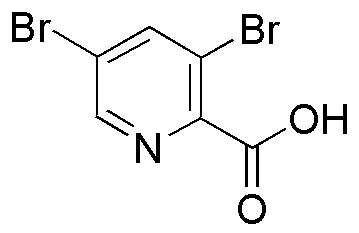3,5-Dibromopyridine-2-carboxylic acid is widely utilized in research focused on:
- Synthesis of Pharmaceuticals: This compound serves as a key intermediate in the synthesis of various pharmaceutical agents, particularly those targeting bacterial infections and cancer. Its unique structure allows for the development of novel therapeutic compounds.
- Agricultural Chemicals: It is used in the formulation of agrochemicals, including herbicides and fungicides. The compound's effectiveness in controlling pests makes it valuable in enhancing crop yields.
- Material Science: In material science, it is employed in the development of advanced materials, such as polymers and coatings, due to its ability to modify surface properties and enhance durability.
- Research in Organic Chemistry: This chemical is a useful building block in organic synthesis, allowing researchers to explore new chemical reactions and pathways, thus expanding the toolkit for organic chemists.
- Biochemical Applications: It can be utilized in biochemical research to study enzyme interactions and metabolic pathways, providing insights into cellular processes and potential drug targets.
General Information
Properties
Safety and Regulations
Applications
3,5-Dibromopyridine-2-carboxylic acid is widely utilized in research focused on:
- Synthesis of Pharmaceuticals: This compound serves as a key intermediate in the synthesis of various pharmaceutical agents, particularly those targeting bacterial infections and cancer. Its unique structure allows for the development of novel therapeutic compounds.
- Agricultural Chemicals: It is used in the formulation of agrochemicals, including herbicides and fungicides. The compound's effectiveness in controlling pests makes it valuable in enhancing crop yields.
- Material Science: In material science, it is employed in the development of advanced materials, such as polymers and coatings, due to its ability to modify surface properties and enhance durability.
- Research in Organic Chemistry: This chemical is a useful building block in organic synthesis, allowing researchers to explore new chemical reactions and pathways, thus expanding the toolkit for organic chemists.
- Biochemical Applications: It can be utilized in biochemical research to study enzyme interactions and metabolic pathways, providing insights into cellular processes and potential drug targets.
Documents
Safety Data Sheets (SDS)
The SDS provides comprehensive safety information on handling, storage, and disposal of the product.
Product Specification (PS)
The PS provides a comprehensive breakdown of the product’s properties, including chemical composition, physical state, purity, and storage requirements. It also details acceptable quality ranges and the product's intended applications.
Certificates of Analysis (COA)
Search for Certificates of Analysis (COA) by entering the products Lot Number. Lot and Batch Numbers can be found on a product’s label following the words ‘Lot’ or ‘Batch’.
*Catalog Number
*Lot Number
Certificates Of Origin (COO)
This COO confirms the country where the product was manufactured, and also details the materials and components used in it and whether it is derived from natural, synthetic, or other specific sources. This certificate may be required for customs, trade, and regulatory compliance.
*Catalog Number
*Lot Number
Safety Data Sheets (SDS)
The SDS provides comprehensive safety information on handling, storage, and disposal of the product.
DownloadProduct Specification (PS)
The PS provides a comprehensive breakdown of the product’s properties, including chemical composition, physical state, purity, and storage requirements. It also details acceptable quality ranges and the product's intended applications.
DownloadCertificates of Analysis (COA)
Search for Certificates of Analysis (COA) by entering the products Lot Number. Lot and Batch Numbers can be found on a product’s label following the words ‘Lot’ or ‘Batch’.
*Catalog Number
*Lot Number
Certificates Of Origin (COO)
This COO confirms the country where the product was manufactured, and also details the materials and components used in it and whether it is derived from natural, synthetic, or other specific sources. This certificate may be required for customs, trade, and regulatory compliance.


